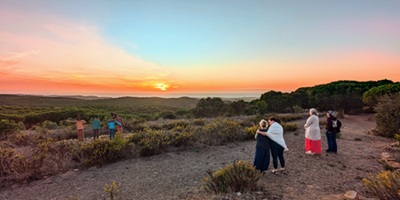As a student of yoga in many forms since age 16, I knew how the practice transformed me. I had no idea there would be so much more in teacher training. The lessons are expansive and plentiful; here are a few:
1. It is possible to love winter.
Before teacher training, I spent two years out of the country living in Ecuador and Mexico and traveling to half a dozen other countries. Upon my return to Chicago, I had not planned to stay and endure another Midwestern winter. When I chose to stay for teacher training, I wondered how I would manage.
I quickly found winter to be the perfect time for introspection. As I heard others complain about the weather, I even found myself saying, “It’s not so bad,” as I spent my time studying, practicing, and cooking up sattvic comfort food.
If you are surrounded by a community of seekers, creators, learners, and teachers, it does not matter where you are.
2. Your greatest teachers may become your greatest friends and your greatest friends your teachers.
Amazing men and women become yoga teachers. In the years past, I thought I needed to live in some bohemian expat community across the globe to find people who “get it” or “get me”. All the while, there was an incredible community of individuals doing deep soul work with their dharma right in my hometown of Chicago. What’s more is that Midwesterners are grounded to begin with, so yoga here is filled with authenticity and real people.
Open your heart to all of the meaningful connections that come into your life. You have no idea where the connections will lead. Gravitate toward the teachers that drive you nuts. You have something to learn from them. Notice how the other trainees become your greatest teachers as you see yourself reflected in the individual and collective process of becoming a teacher.
3. Dogma comes in all forms and serves no one.
I used to think of myself as this policy wonk. I fought tooth and nail with my dad at every meal about matters of foreign policy, poverty–you name it. I couldn’t wait to expound on all of my progressive ideas I had accumulated at the University of Wisconsin-Madison. My dad and I would sit around bolstering up our egos while our relatives rolled their eyes.
When I began practicing Ashtanga Yoga, I started to let go of the attachment I had to political convictions; however, the dogmatic part of me took a new form. I began to think of Ashtanga as the best form of yoga. This was my path and surely this would be the only form I would teach.
Thanks to Moksha Yoga Center’s wide array of teachers and philosophies, I learned to open my heart to so many other amazing practices. I find something that serves me in every class I take, and this well-rounded exposure will ultimately serve my students. Interestingly enough, Ashtanga has become that much more meaningful to me because of the sensation of openness I carry.
You can always find ways to bolster up your ego—even in yoga; bolster your sit bones instead.
4. Trusting our own intuition can be the toughest challenge.
Yoga Sutra 1.2 states, “yogash chitta vritti nirodhah”, which can translate to “yoga suspends thought activity”. Yoga calms the mind and you come to yoga to let go, right?
The irony is that sometimes the more you practice, the more “chitta vrittis” (“mind stuff”) you must learn to suspend. Teacher training disrupts any sort of thought management system you believed you had nailed.
I have an entire cabinet of voices in my head at any given time during my practice telling me how to breathe and arrange my body on the mat.
All of these voices become a turbulent tornado as you wonder who and what is right. Learning your own body and breath to know what is right for you is truly the work here…that evolves as well.
5. Language and teaching = empowerment.
I had no idea it would be so hard to cue yoga poses. Really. Language is everything and cuing requires careful attention to precision and various “layers” of cuing stance, breath, feeling sensation, etc.
By bringing my attention to language for how to cue yoga sequencing, I have also redesigned how I apply my language overall. I’m not “bad at Supta Kurmasana”, but “Supta Kurmasana is a challenge for me”. I refrain from using negative phrasing whenever possible and this has shifted my sense of self and interface with the others.
Perhaps the biggest lesson in yoga teacher training is finding your own “teaching voice” and confidence with leading.
6. Just when you think you are taking responsibility for choices, you realize there is more to take.
As a teacher trainee, you will be compelled to look in the mirror and accept full responsibility for what you create. Victim language and attitudes are nothing new to me. I believe that karmically we choose our parents based on what we need to learn; this makes the blame game impossible.
Yet, I realize that I have made certain choices (namely career/work changes) during my teacher training journey, which have absolutely wreaked havoc on my routine. Who made those choices? Why? Whose responsibility is it when I don’t show up to my mat?
Yoga helps us to see ourselves more clearly and take a look at why we might not be showing up 100 percent in our practice, relationships, jobs, and with ourselves.
7. Make time for your own practice
I hear so many people say that they began teacher training to “deepen their personal practice”, not necessarily to teach. Well, as I have illustrated, it is almost certain your personal practice will deepen off the mat in your behavior, food choices, and thought processes.
The largest challenge for me has been making time to deepen my practice on the mat. Workshops, reading, apprenticeships, thesis projects, and other course requirements become convenient excuses for skipping personal practice.
Be prepared that your formerly focused practice will now be laden with voices from various teachers, which may lead you to question what you are doing.
Your body will crave yoga and you will think of ways to ignore that craving. Listen to it when it calls.
8. It’s okay to dare to be the weirdo, if that’s who you are.
There is this thing about sitting or standing for too long that just kills me and I feel a need to stretch or balance on a limb. So, yes, I find myself unknowingly taking vrksasana/tree pose in the middle of a social gathering while telling my cousin about my moon cycle, as she laughs and says, “Your moon cycle?”
I don’t mind if people think my eating habits are strange. And it’s okay that I’m not seeking a husband and children. I do what I love and what feels right.
I have spent my life feeling like an outsider in a world driven by consumerism, television, and working oneself into the ground for 50 years to be able to enjoy life when your 70. I don’t get it.
Being in teacher training has shown me that there are other weirdos like me, and even weirdos that want to learn from this weirdo.
9. I have so much to learn.
It’s called practice for a reason. Yoga is a journey of discovering union with yourself and the surrounding world. The more I experience and learn, the more I realize there is to learn.
Study with many teachers in many forms. Study with yourself.
Namaste, peace seekers.


Awesome reflection, Melissa! I appreciate #’s 2, 6, 7, and 8… It’s amazing how you can learn from people all around you, in the least expected moments, too…and there’s ALWAYS more to learn, gain, and take away from in life.
I like how you applied this to your yoga. Still can’t wait for you and Alena to link up and you can show her some yoga moves. She’d love it! Maybe I’ll join in? :o)
♥♥
Amber
All the Cute